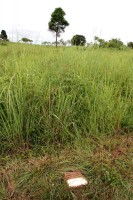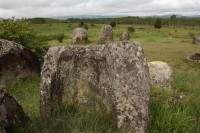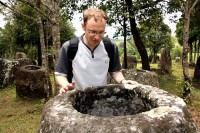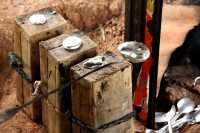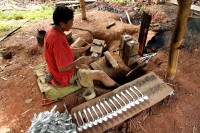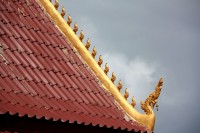We knew it before arrival: Phonsavan is not the most beautiful of cities. We couldn’t know that it would be so boring that the first thing we looked for was the fastest way out…and even accepted yet another night bus, simply because the next flight out of this incarnation of boredom was two days later only. In our original itinerary Phonsavan occupied three days: One day of bus travel from Luang Prabang to get there (that still took place on 30-AUG), one day for visiting the Plain of Jars (the main and for most tourists only reason you get here at all, 31-AUG), and one day to travel on to Vientiane. With the night bus option we could save that travel day and made it instead a travel night.
The mini van ride from Luang Prabang to Phonsavan was long (6 hours), but not especially eventful. The major highways are sealed by now. But still, they are winding their way through mountains. They are curves stringed together. Think of serpentines in the Alps, but the sharp curves not wider than the normal street, and that for 350km, and you get about the idea. The landscape was not exactly boring, but after some time even the most interesting mountain landscape offers no new features to stare at. The street was dotted with hill tribes’ stilt houses every other kilometer. That’s about it.
The good thing is: Once you left Luang Prabang you couldn’t go wrong. The next intersection was some 150km further south, when highway 7 gets off highway 13. We followed highway 7 east to Phonsavan. On the way back from Phonsavan down to Vientiane it was the reverse: 200km highway 7 to the intersection, then continue south on highway 13 to the capital city.
It was about 5pm when we arrived in Phonsavan. We checked into a guesthouse and walked up and down the street. There was not much…small eateries, probably a store, a few ladies selling fruits, that’s about it. Two other backpackers approached us asking if we found anything…not in this direction…well, not in the other direction either…eh, ok…enjoy!
OK, that’s not entirely true: There are two information centers regarding UXOs, “UneXploded Ordnance”, a major problem in Laos. While many people are aware that mines and bombs are still a threat in Cambodia (and even in remote areas of Vietnam), Laos is not so much in public discussion. However, Laos is the most heavily bombed country in world’s history (by number of bombs per people, if I’m not mistaken). That is not only a result of bombing the Ho Chi Minh trail during the American Vietnam war, but also and even more so due to bombings in support of what now is called the “secret war”, the support of anti-socialist armies in Laos in their fight against Pathet Lao. UXOs, especially the so-called “bombies” (the mini bombs, which were the load of cluster bombs) still cause hundreds of dead and seriously wounded every year. The country is slowly being cleared from them, but it’s a tedious process. But as long as the land is not cleared it cannot be farmed and no infrastructure can be built. UXOs seriously hinder Laos’ economical development.
One of the organisations helping in clearing the land is MAG. They have an information center on the northern road of guest houses and offer a highly informative movie (if I got it right every evening at 6 or 6:30pm). You can’t do anything in Phonsavan anyway in the evening after arrival. So go get there and watch that movie.
Next to MAG is a restaurant named “Craters” that serves a good noodle soup and some sandwiches (and even pizza, which Nina claimed was good, though it looked a bit simplistic). That made for our dinner, and the we went to bed already.
Plain of Jars
We had opted for a private guided tour, just not to get stuck with slow tourist groups. Well, these groups would have never been large. But that way we could also include the old capital and could decide on our own speed.
First: But before we get there we need to talk about UXOs again. The Plain of Jars has certainly not been spared from bombing. The areas interesting to tourists have been cleared for the tourists to come and bring money. But they are clearly marked and often not wider than one meter for a foot path from one spot to another. Marks are by stones with clear white/red stripes: White is cleared, red is bad. Stay between the white marks. The land beyond the red mark is basically unused and still awaits clearing from UXOs.
Second: Also available as intersection marker.
Third: And for those not obeying the marks can become even larger: The tourist official are serious about the topic.
Site 1
The Plain of Jars is divided into three sites accessible to tourists. There are more being examined and cleared. Site 1 is the largest.
First: A broken jar, in which you can guess how thick the jar’s walls were.
Second: The largest jar across all sites. In the background a mountain where unfinished jars were found. One theory of the jars’ creation is that they were created in that far away mountain and then carried to the sites as urnes for ashes. So we would basically be walking on a huge graveyard.
Third: There were some very few lids around. Expectation is that all jars had lids. And a theory to the rings on the lid is that a lid could cover any sized jar: One of the rings would always fit, i.e. the lid would sit on the jar upside down, not like here on this picture.
First: Looking across site 1.
Second: And now for something completely different…that frog waited patiently until I made my photos.
Site 2
We moved on by mini van to site 2. It started slowly to rain and roads out in the fields were not sealed. The van started to have issues getting along, but we always made our way. Site 2 was a lot smaller, but the entire setting was a lot more beautiful: On a small hill overlooking the surrounding fields, under trees. That was a good place for a final rest. Cows were around, too. The guide admitted that most people liked site 2 best.
Site 3
We liked site 3 best. But the rain had turned into a post-monsoon rain. We reached that site by van (we could have walked there for an hour, but due to the increasing rain had decided against this promising option) and according to our itinerary we would have a noodle soup lunch first anyway. After the lunch break the rain ceased and we could start our short walk from the entrance through some rice paddies to the actual site.
First: Rice paddies and our path through them to the jar site.
Second: A caterpillar on rice plants.
First: On the actual site: The jars looked pretty much the same, but were a lot more densly scattered around the small site, which again lay on a hill.
Second: From this last photo you can finally guess the jars’ size: I am standing behind a pretty much average specimem of a jar. There were some even larger ones, but not too many.
Spoon-Making Village
One aspect of all the bombs dropped on Laos is: They are made from precious metal. Also other sources of metal were left behind, like crashed airplanes or abandoned tanks and cars. We were offered to be brought to a spoon-making village and hence knew that the spoon we had used for lunch, which looked a bit weired, was probably from there. That village turned out to be just a normal hill tribe’s village and there was exactly one villager pursuing his profession as spoon maker. But that was interesting a visit nonetheless:
First: In the front there’s the metal (he uses aluminium) sold to the spoon maker by villagers around, who found it on the fields. There’s also a small coal fire to melt the aluminium.
Second: The spoon maker has some spoon forms, held together by wood and strings. He fills melted aluminium into the forms. Any left-overs (and also bad spoons) are simply thrown into the coal fire again.
First: The finished spoon is taken from the form after only some seconds of cooling down.
Second: The production site once more, with an array of finished spoons for cooling off.
We directly supported local economy by buying five spoons for 10.000 kip (about one Euro). We are still discussing how to use them… 😉
Update: We put them into the dish washer and will then just use them…
Muang Khoun (Old Xieng Khuang)
The last stop was the previous site of the province’s capital, which was so heavily bombarded that it was nearly abonded in 1975. People had moved to Phonsavan (where, you could ask, or what are they doing there all day…but that’s others to answer). We had hoped for some ancient ruins, a scent of Ankor maybe. But all we were offered were:
First: The remains of an old temple.
(Second: A naga with a bell ringing in the wind.)
Third: An old stupa. That thing was a cool sight. Meant to hold the ashes of a king, if I remember correctly. The queen’s stupa could be seen several hundred meters away, but was more heavily damaged.
That’s it. Not worth the ride. It’s 24km outside Phonsavan.
Back in Phonsavan we waited away the two hours until we should be picked up for our night bus. We really wanted to get out of this town! We just had another pizza and sandwhich at The Craters.
There was some discussion and confusion about the bus schedule. There are two night busses to Vientiane, a local one and a VIP one. We certainly wanted the VIP bus. It was 115.000 kip instead of 90.000, so not even much more expensive, but said to have reclining seats and a toilet on board. Supposed to leave by 7:30pm. But then we were told during the day due to too few people having reserved tickets the two busses would be combined into one leaving at 6:40pm (like the local bus would anyway). We had insisted that we had paid the higher price and wanted double confirmation that the bus being used would be the VIP bus. After some back and forth we were told so.
 Eventually, we were picked up at 6pm from our guest house and brought to the bus station. There were two busses: A local and a VIP. The tuk tuk driver pointed to the VIP bus, gave us two tickets, and said “8pm”. What???
Eventually, we were picked up at 6pm from our guest house and brought to the bus station. There were two busses: A local and a VIP. The tuk tuk driver pointed to the VIP bus, gave us two tickets, and said “8pm”. What???
The bus station in Phonsavan is very well organised. If you ever get there, get your tickets directly there and avoid the local tour operators. There are two busses. And they run every day. The local at 6:40 (avoid that) and the VIP bus at 8pm. And so it was today as well. We had the right ticket…we just had to wait 90 minutes at that bus station 4km outside a town which was also not worth being waited in…but as long as these 90 minutes stretched…at some point in time they were over and we could board our VIP bus. Seats were assigned, which is good. And we had number 1 and 2: The two front seats on the upper deck with premium view outside the front window.
As expected the air condition cooled down the bus to an icy level. But we were prepared with fleece jackets and towels. Still it was damn cold…
The ride itself was certainly interesting as this huge bus would need to use the very same winding roads. And only if you did a trip during daytime you can fully foresee all the dangers that could happen to you: narrow serpentines, deep mountain ridges, oncoming traffic, huge trucks in needle curves, slippery roads due to monsoon rain, and worst of all: cows on the streets.
All of that happened to us, but we are still alive due to the very careful and sensible drivers. I had positively comment on Laos’ traffic before and I like to reiterate it: All traffic on the winding dark roads went very careful, leaving each other the room to operate they needed. It didn’t feel scary any moment.
Nonetheless, we could sleep only a bit, mostly due to the freezing cold and the bumpy roads, causing a continuous atmosphere of loud cracking noise. I felt with the shock absorbers. They had an awful job to do. And they groaned with every pothole…
One more thing to add: Schedule was kept down to the minute! The bus left at 20:00 sharp. A break was scheduled for midnight, which we had at 23:50. Arrival in Vientiane was schedule for 7am. And we were there at 07:00 the next morning!
A shared tuk-tuk brought us from the bus station into town and dropped us off near our preferred hotel. Unfortunately, that was full (or at least said so) and we walked on to our next option, which gave us a room, where we had a rest before starting to explore Vientiane, our last place to see in Laos.
Today’s Lesson: Beware of UXO!
